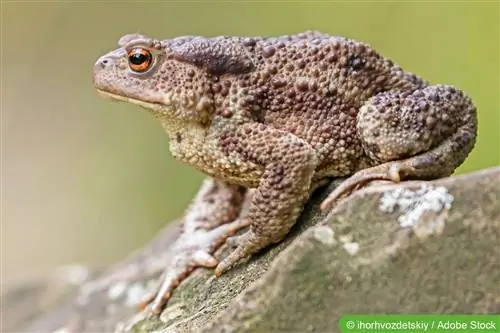- Author admin [email protected].
- Public 2023-12-17 03:39.
- Last modified 2025-01-24 12:45.
The common toad (Bufo bufo) belongs to the toad family, sometimes it is also called the field toad, common toad or mummel. We have put together the most important information about the most well-known toad species for you here.
Characteristic features of the common toad
- The males reach a size of up to nine centimeters, the females are usually slightly larger, up to eleven centimeters.
- Common toads look very clumsy and are not exactly beautiful. They have squat bodies and round snouts, and the entire body is also equipped with skin glands that look like warts.
- The common toads have two glands on the back with skin toxins that serve to ward off natural enemies.
- The colors of the skin range from reddish brown to light brown to black and clay-colored. The belly sides are light to white.
Occurrence & Habitat
- The common toads are relatively widespread and common. They can be found throughout Europe, in parts of Russia and North Africa.
- Since common toads are active at dusk, we rarely see them during the day because they hide under stones, in walls or in bushes. But when it gets dark, they come out everywhere, be it in meadows, in hedges or in forests and gardens. Their way of life is relatively adapted, so that the common toads can also live in gravel pits and other very dry areas.
Reproduction of the common toad
The common toad needs water to reproduce, and it prefers ponds and lakes, as well as ponds or garden ponds, provided there is enough water. In spring, whole herds of toads migrate from their winter quarters to their spawning grounds. When pairs find each other, the male is carried to the water.
The spawn itself is released in the form of strings that can be a remarkable five meters long. These are black eggs that are stuck in a kind of gel. When the spawn comes out of the female's body, the male releases his sperm onto it. The entire spawning process can take up to twelve hours and consists of several spawning spurts and breaks. The number of eggs laid can vary, but is usually between 3000 and 6000.
Little black tadpoles develop from the eggs. After another three months, the animals become land animals with lung breathing. It takes another three to four years until the common toads reach sexual maturity and spawn again.
The diet of the common toad & its enemies
- Redbirds feed on all kinds of small animals, including worms, spiders and woodlice. The prey is swallowed whole. The common toads therefore also have an economic benefit; they are kept in organic gardening as pest controllers.
- Of course, the common toad itself also has a large number of natural enemies, including raccoons, songbirds, predatory fish that feed on the tadpoles, dragonflies, but also the polecat should be mentioned, as well as parasites that cause problems for the toads.
- But humans are also among the common toads' enemies. Road construction is cutting up their habitats and vehicles are interrupting or even ending their migration. Another problem are cellar shafts and manhole covers, the toads fall into them and starve.
- There are therefore already a number of protective measures, such as fences that are erected during migration periods, replacement spawning waters that are safe or so-called toad tunnels that help the animals to cross the road safely.to cross under. However, there is not yet a serious threat to our continued existence.






